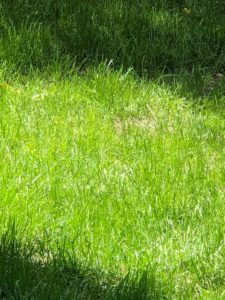 The other morning, I marveled at the lushness of the grass; the way individual blades sprout up with no room between them and their neighbors, how dew clings to each surface before the day gets too warm, how looking at a patch can make the sun seem more damaging and shade more inviting.
The other morning, I marveled at the lushness of the grass; the way individual blades sprout up with no room between them and their neighbors, how dew clings to each surface before the day gets too warm, how looking at a patch can make the sun seem more damaging and shade more inviting.
I thought about the pride in which greens are described at favorite golf courses, about how grass is trimmed and tended to give baseball fields their unique looks.
I’ll laugh to myself when I think about how homeowners take on the expense to put in new sod regularly and about how grass does not seem to grow in certain spots no matter how much water, sunlight, or chemicals are applied.
Supposedly, there are about 12,000 species of grass. (I have to trust Google on this.) Some grasses are more suited to flourish in warm climates, other types where cool temperatures prevail.
Some types grow best in moist soil, others in sandy soils.
Some grasses are known for their shades of green (or blue, as in Kentucky bluegrass).
Some species, like buffalo grass, are low-maintenance. Other species, like Bermuda grass, require frequent mowing and fertilizing.
In troubled times, it’s hard not to look to nature for examples of renewal, symbols of eternity. Grass provides a very accessible and immediate way to experience nature. For most of us, grass is everywhere.
Poet, Brian Ingalls, wrote:
Grass is the forgiveness of nature –
her constant benediction.
Forests decay, harvests perish, flowers vanish,
but grass is immortal.
I could wax on poetically about the beauty of grass swaying in an early summer breeze, or how grass is such a great example of infinite variety, or how grass in a park or near a beach seems to invite me to spread out a blanket for a picnic or short afternoon nap in the sunshine.
But my mind seems to be filled with one thought.
BAREFOOT.
When I see a square of cool grass — a little wild but not too tall where I might worry about unseen surprises — all I can think about is walking through it barefoot.
In grass, I can easily reflect on spiritual things while feeling very much a being of the world. I want to feel the cool dampness on my soles, narrow wisps of chlorophyll modified water and lignin against my skin.
Feeling the texture and temperature is just the beginning.
As important as it is to notice the sensations that are present, I’m also drawn to think about what is blessedly absent.
Socks and shoes.
Walking barefoot in the grass is a quiet declaration of freedom. For me, it’s is like being a nudist — from the knees down — a comfortable level of living without restraints.
Walking in the grass barefoot is about the sensuality of my skin coming in contact with the skin of the earth.
I know Walt Whitman wrote about this sort of thing, speaking about the sacredness of the human body. In following my curiosity about why he titled his famous poetry collection “Leaves of Grass,” I learned that he was poking fun at publishers and critics by the reference.
“Grass” and “leaves,” were terms that implied limited value, as if memorable literature or poetry had to encompass high-minded themes. Yet, the urge to take my shoes off and feel alive in my body, tells me otherwise.
Walking barefoot in grass is no small thing.


Leave a comment